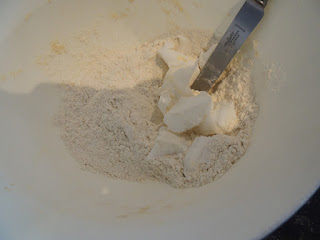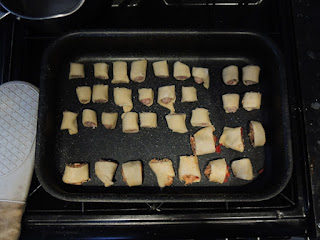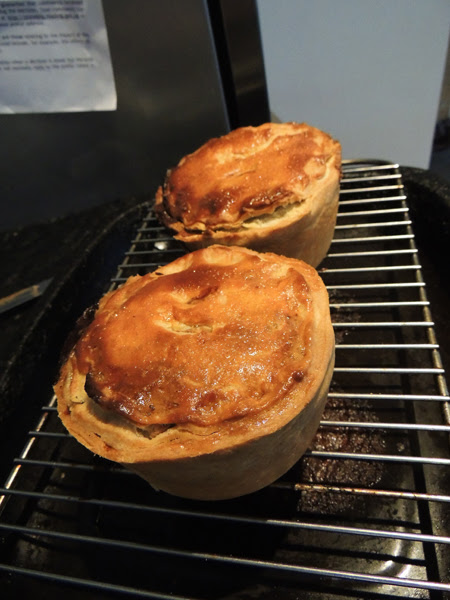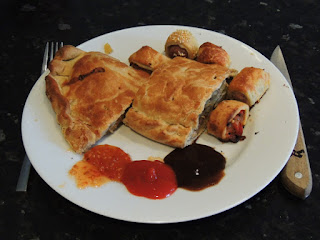Q. What happens when you go out, and someone fab gets started on the subject of meat pies?
A. Pie morning!
One Sunday morn there was a coincidence of having recently had a great conversation about making pies and other savoury pastry-based yums, with not having any specific project on the go.
The end result was that I couldn't help going a bit nuts on the exploratory baking front.
I make lots of pies and can easily knock out a meat-infested pork pie or oozing steak-and-kidney, using hot home-made water crust or shop-bought puff pastry, but I had no idea what the correct pastry for pasties is.
After some comparative web scouring, it turns out that Cornish pasty pastry should be a kind of kneaded short pastry but using hard bread flour with lots of gluten. It also transpires rough puff pastry (otherwise known as flaky pastry) is OK too.
There's even a Cornish Pasty Association. They have a recipe...
www.cornishpastyassociation.co.uk/about-the-pasty/make-your-own-genuine-cornish-pasty/
A tale of two crusts
As we all know, nobody agrees on the exact definition of anything, so there are pie factions that dispute the exact way a cornish pasty should be made. Happily, I don't really care as long as it tastes epic. And thus, today I baked for hours using the two pastries with the highest consensus:- Cornish pasty pastry
- Rough puff or flaky pastry
This post loosely recounts the baking session. In it, I was using the two pastries to make three things:
- Cornish pasties
- Steak and kidney pies
- Sausage rolls
You don't need much kit
Apart from working your fingers, hands and arms, you don't need fancy tools. I have a handy baker's batter smoother/dough cutter (the cream thing, centre) which is very useful, but NOT essential.Butter knives are handy and silicone slicers are excellent.
Variations in the two pastries
These both use strong bread flour with high gluten content, but the fat content differs and they are made differently. I used these ingredients for my pastries
The Britannia packet is beef dripping. The yellow packet is hard margarine, used for cake-making usually. I only used plain flour for dusting really. Both had plenty of sea salt in them. Crushed to a powder using the wooden pestle and mortar.
The rest of the tools were largely just the scales, a bowl, a wooden spoon and a silicone latex scrape.r/folder.
Rough puff or flaky pastry
This is like puff pastry, but without the sheets of butter. I used 200g of bread flour.
And half marg, half beef dripping. 100g of each.
The fat was chopped up rough
Until it was smallish blocks, but not too small!
The traditional method of rubbing in fat into flour was used.
Although I find that really tiring, so I usually rub fat in between my fingers vertically by moving my whole hands. Much less fatiguing...
Plenty of salt is needed!
A whole teaspoon...
200ml of water was added, bit by bit..
This was stirred in slowly until the dough started binding to itself...
This slightly gooey paste was tipped out...
You can see the crumb...
And the pastry was kneaded to make it more elastic. I didn't do this for too long.
Just enough to get some stretch in it, but nothing like as long as when you make bread...
You can see the big lumps of dripping still in it. This is important.
Here's the finished pastry ball...
To the fridge - in you pop!
I left to stand and cool for about 25 minutes.
Pasty pastry
This flour starts in a similar way, BUT only uses half the fat - 100g of beef dripping. The flour was 200g as before.
But in this case, it was rubbed in quite finely, more like a short crust pastry (at least to start with)
The fat/flour crumb is obviously much finer than with the rough puff.
This pastry also used 100g of water. This was stirred in slowly. The pastry clumps, slowly at first.
Until it starts to form a ball. You should add it slowly after this or it may get too wet.
I turned this out onto the counter.
But in this case, I kneaded the pastry for quite a long time to make it really elastic - much more like a bread dough.
I knead you baby...
You need to really push it to tease out those proteiny lengths of gluten...
This can take 5 minutes or so...
Both pastries resting in the fridge. We all need a rest between kneadings sometimes.
Make fillings while pastry rests...
The fillings got made next because I had to wait for the pastry to rest in the fridge.
Pasty filling 1 - traditional
- These are the traditional pastry innards:
- Beef skirt, (although I used rib-eye steak)
- Salt and pepper
- Potatoes
- Swedes (also sometimes called turnips, although they are not turnips)
- Onion
The swede was chopped into bite-sized chunks
And the same with the spud
The beef was cut using scissors because it's just easier.
And some diced onion.
TIP - leave the root on to make this easier
Chop vertically...
Then cut across the grain to get the dice
The finished filling...
Obviously you need loads of black pepper...
And a fair amount of salt...
Pasty filling 2 - non-traditional
As this was an experiment into pie variations, I used some leftover chilli sausages to create a second non-traditional filling.I still used swede, potato and onion...
And mashed the sausages up...
I like hot food, so I popped some chopped chillis in.
Scissors are great for doing this.
The finished filling. In this case, I had added the pepper by the time the shot was taken.
Steak and kidney pie fillings
The pies needed an actual. There is no potato or swede in a steak and kidney pie. They do have onion and also can have beer. I sauce used this tasty dark porter.Which always tastes better if you open it wit a vintage bottle opener...
Like this beauty...
Start with the kidneys
I always start a steak and kidney pie by frying the kidneys and making a base sauce. I use this to fill the pies, but keep the steak raw before baking. The steak cooks in the oven.So lots of buttery spread...
Then chop up the kidney into reasonably large pieces. Note it shrinks on cooking so don't make them too small.
Once you've cut off the main red fleshy bits, you get left with a tough mass of kidney tubules.
You definitely don't want these...
Not sure if that is kidney or pug tongue...
That tongue is absurd.
She hung around for ages after it was all gone, trying to look as cute as possible...
Anyway, the butter spread got melted
Ready for the lovely fleshy flaps...
In they pop...
I cooked these for a while to cook and let the steam off.
Eventually after the moisture is cooked off, the kidneys start to brown. At this point, you need to stir it.
To make the sauce thick, I add some flour - keep stirring!
Eventually you get a delicious thick kidney-based roux.
Into the roux went the dark beer...
It fizzes satisfyingly...
You get left quite a lot. A good use of this is to drink it.
Although the rest of the baking gets a little fuzzier...
The sauce emerges.
Use enough beer stirring into the roux to make a thick sauce.
Added gravy. This is leftover gravy from the day before's roast dinner...
Stir it in...
Interlude - back to the pastry
Cooking the kidneys took a while. By the time it was done, it was time to come back to the pastry and roll it outRolling out the rough puff
The cold pastry was popped onto a floured surface.Then rolled out to about three times its length
You can see the fat lumps...
Once longer, it was folded in three...
Like this...
This is what it looked like on the bottom...
And again, after folding...
Before rolling...
It ends up looking like this.
The finished rough puff pastry...
Rolling out the pasty pastry
The same folding technique was used with the pasty pastry. It won't rise the same, but it does help make it slightly lighter.
The texture is obviously much more even because it doesn't have big lumps of fat like the rough puff pastry does.
In close-up
ASSEMBLY!
Once the pastry and filling was done, the exciting job of building the pies could commence.
I made two steak and kidney pies using some classic stove enameled pie dishes (I rescued about 30 of these from a skip once - bargain!)
These were lined with the pasty pastry...
Cut round the pies...
Squash it in...
Use your fingers...
Next get the steak in. Scissors again...
So the pastry shell gets a layer of steak pieces...
Then the kidney sauce is slopped on top...
Not poured, filled, whatever - slopped!
The silicon spatula gets those precious last bits out...
mmm - pie filling...
Using another pie dish, cut out a crust...
beat some egg...
Slap it on to seal the edges...
Stick the lid on...
And thumb crimp...
And trim off...
You need to make some holes. to let out the steam..
Beaten egg glaze atop...
In they pop...
Give it 25 minutes...
Here are the beauties. Thy had at least another 35 minutes
pie cook
Pasty filling
Trad pasty filling...
A circle of pastry, with some trad filling...
Egg the edges...
Press it over...
And crimp (a bit craply, if I'm honest)
These are up for gas mark 6
To stop them sticking, grease the pan...
Stick on some greaseproof paper...
Pasties also need holes to let out steam...
Spread them out...
Non-trad pasty filling
Take two...
Slap on the slop...
At least this one is a bit neater.
OK, both pasties, ready to roll. Pricking some air holes...
And glazing with salted beaten egg.
And after about 40 minutes - fuck yeah!
They were left on the grill pan grid to cool...
Final round - SAUSAGE ROLLS!
The remainder of this bakey session was about using up pastry offcuts to make sausage rolls.The same piece cut into pieces with chipolata added. These are from Asda and are the best ones I've found.
They were rolled and crimp-sealed...
Hmm...
The crimped seam was folded over...
It's surprising how many you can cobble together...
These were sliced into bit-sized rolls with the cleaver...
Thus...
As well as the classic plain pork chipolatas, I also had some chilli sausages. These were supposedly hot, but not really, so added some chopped chilli and some Encona chilli sauce, which really is hot...
Finesse - who gives one about that?
The various rolls after cutting...
Some were egg glazed.
Some were milk glazed...
Some with sesame seeds...
The full range, ready for cooking.
Some plain filling with egg glaze
Some plain with cheese topping
Some sesame
Some pasty pastry
Some flaky pastry
Some chilli filling
Chilli filling with cheese
BEFORE
and After...
Foodporn shots #1 - sausage rolls
Foodporn shots #2 - Pasties
Foodporn shots #3 - Steak and kidney pies
Foodporn shots #4 - Lunch
Trad pasty and pug
Trad pasty pastry...
Non-trad pasty with flaky pastry
mmm...
flaky...


















































































































































































